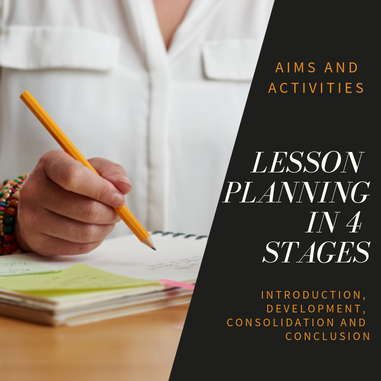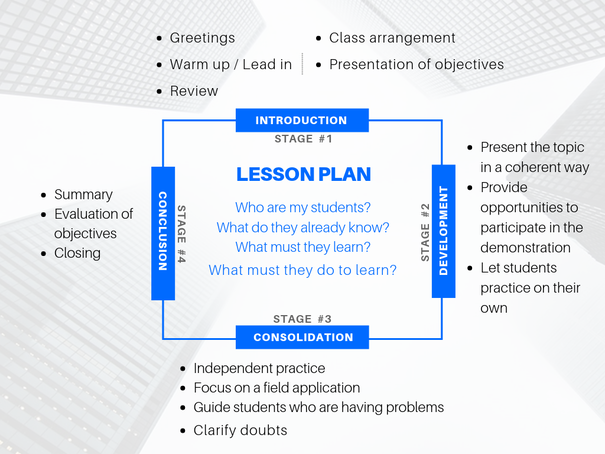Although there are many possibilities, here is an example of the stages of a lesson:
- Introduction
- Development
- Consolidation
- Conclusion
STAGE 1: INTRODUCTION
This stage provides interest and motivation to the students. Before starting the class, this stage focuses on the greetings, warm-up or lead-in, review, class arrangement and presentation of objectives. Regardless of the amount of time available for the lesson, this part should only last 5-10 minutes.
To set a purpose
- T describes/explains the aims for the lesson.
- T asks Ss to rearrange the aim as an anagram – Ss try to puzzle it out.
- T writes a few discussion points on the board about (topic).
- T sets the environment by presenting a video/audio of (topic).
- T asks Ss to brainstorm what (topic) means.
- Ss briefly discuss in pairs what they think (topic) is.
- T brings in realia (real objects) related to (topic).
- T places key terms or vocabulary words into a “word cloud” and asks Ss to find words related to (topic) and generate new ideas.
- T asks Ss what they remember about (topic).
- T asks Ss to guess the name of (book titles) by listing keywords.
- T asks Ss to label images.
- Ss match the vocabulary with images.
- T shows flashcards and Ss try to describe them.
- T writes a list of words on the board and Ss categorize them.
- T gives Ss a keyword related to the topic and then gives them x seconds think up as many linked words as they can.
- T writes groups of 4 words on the board and Ss have to find the odd one out in each group.
- T asks a volunteer to come out and draw a card. Then he/she is requested to act out the action written on the card.
- T asks Ss “Can anyone remember what we did last week/class?”
- Ss play a jeopardy game (answer-and-question quiz) about the previous class.
- Ss discuss what (textual or graphic component) is used for, the intention and purpose.
- T shows Ss (a text/book cover) and have them predict what it could be about.
- T asks Ss to identify the title, subtitle and author.
- T asks Ss to talk about their favorite (subject matter).
- T elicits from Ss the most common (subject matter) in their area.
- Ss discuss and rate a list of (subject matter) according to (specific criteria).
STAGE 2: DEVELOPMENT
This stage is the most student-centered part of the process. The activities for this stage present the subject matter in coherent way and provide students opportunities to participate and practice.
To provide controlled practice of the target language
- T says (models) the word or phrase and Ss repeat it.
- Ss complete a gap-fill activity.
- Ss read a text and do a true/false activity.
- Ss read a text and answer some questions.
- Ss do a jumbled activity.
- T reads aloud descriptions and asks Ss to try to guess what it is.
- Ss form their own complete sentences by choosing vocabulary from a sentence formation table.
- T asks Ss to read until they find out where the story takes place.
- T asks Ss to find someone who (specific criteria).
- Ss solve a crossword puzzle.
- Ss work in teams in order to (task).
- Ss share what they found with others.
- Ss ask their peers to arrange/number the dialogues in the correct order.
- T asks Ss to practice the dialogue several times.
- Ss exchange information about (topic).
- Ss chorally repeat the sentence pattern.
STAGE 3: CONSOLIDATION
This stage is called “Independent practice”. It gives students the opportunities to use their newly learned knowledge and skills. It focuses on a field application and provides time for students to get their doubts clarified.
To provide free practice of the target language
- Ss write a letter responding to a message.
- Ss write a short conversation with a partner.
- T asks Ss to write down what they think will happen next in the story.
- Ss draw a concept map about all the elements in the story (setting, characters, plot, theme and conflict).
- T asks Ss to write an alternate ending using the information that they have learned in a story.
- Ss adjust their dialogues with the characters’ interventions as much as they can.
STAGE 4: CONCLUSION
This stage has 3 parts: summary, evaluation of objectives and closing. A brief summary or overview is often appropriate for checking understanding. Also, the students should be able to demonstrate that they have reached the objectives. The closure step is also a chance to give students feedback on their performance.
To summarize and check understanding
- T invites Ss to tell class what they have learned by answering some questions.
- T asks Ss to practice what they have learned by asking them “exit tickets”.
- Ss create their own vocabulary picture.
- T writes several yes/no questions of key points from the lesson and asks Ss to raise their thumbs up/down for each one.
- T gives feedback on (topic).
- Teacher gives a quick conclusion and explains some common error.
- T gives homework and assignments for the next class.
- T makes contributions to improve Ss’ (writing/reading/listening) skills.


